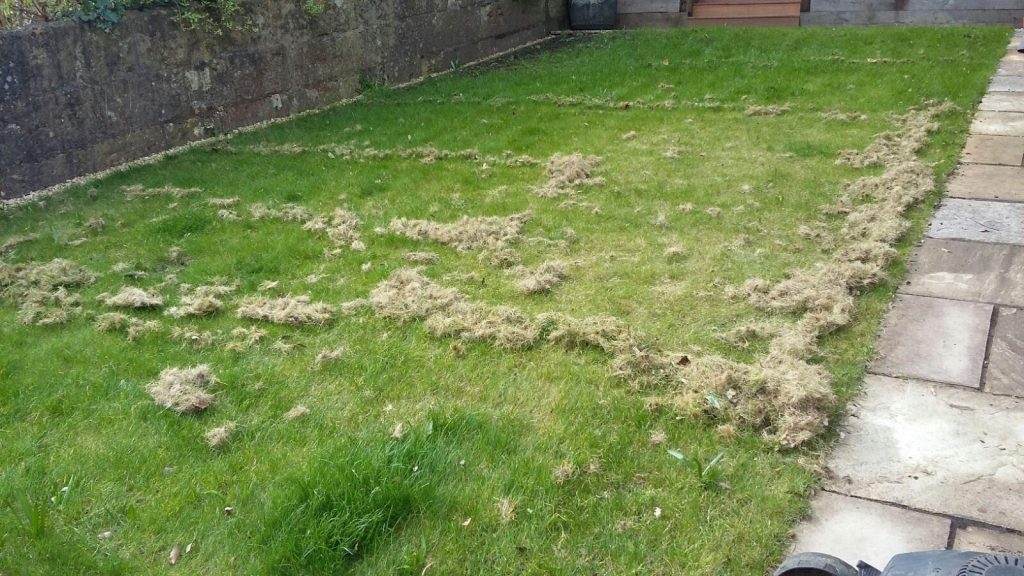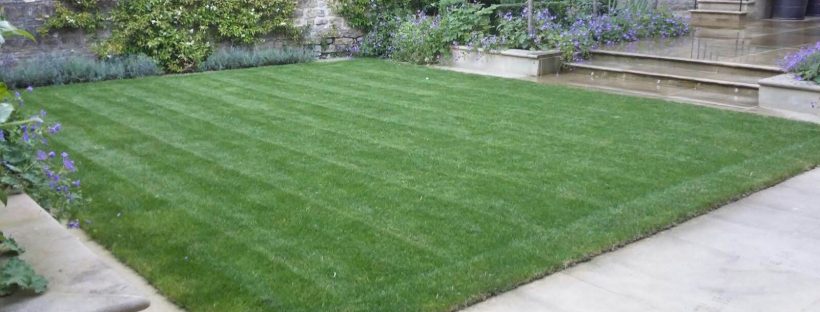The perfect English sward is a source of amusement amongst some of the local Frenchies here, but no-one can doubt that a neat lawn does beautifully set off neighbouring planted beds. Lawns are one of the higher maintenance and less environmentally friendly areas of the garden, but they can still have a place in the garden being perfectly suited to rest, relaxation and play.
In the UK where the climate is much milder it is possible to begin your lawn care regime in spring time, as the temperatures are never too hot for too long to be of any detriment to newly laid turf or seed. In the the Poitou-Charentes the climate demands that your lawn care programme for the year ahead actually begins the preceding autumn. This allows any new turf or seed three full seasons of growth to establish before the blistering heat of summer arrives.
September/October:
Lawns by this time of year are often still in recovery mode from being scorched dry the preceding July and August. The lawn will undoubtedly be full of dead, brown, grass blades, making the lawn appear an unsightly patchy mish-mash of brown and green. Some attention at this time of year will help the lawn to recover and keep it looking smart and healthy.
Start by mowing the lawn. Mow shorter than you usually would just to give the grass seedings (see ‘overseeding’ below) a chance to germinate and grow on well amongst the existing grass before you mow them for the first time.
Scarify the lawn of all the acumulated dead grass leaves and any moss buildup. Use a scarifying rake, or if the lawn is large use a motorised scarifier. This will bring to the surface all the dead material in the lawn that can clog it making it look untidy and prevent water and nutrients penetrating deeply. Collect up and remove all this material from the lawn and add it to the compost heap. The lawn will look rough after this treatment, but it will recover quickly looking much better than before.

The lawn might benefit from another mowing after scarification as the act of scarification does tend to lift any laying blades of grass that will have been missed on the previous mowing.
Once the lawn has been scarified and cleared, it is ready for overseeding. Evenly broadcast your chosen grass seed across the lawn to fill the gaps and any larger bare patches. To ensure an even coverage sow half the amount specified on the packaging by walking in one direction across the lawn and then sow the remaining half by walking the lawn at a right angle to the previous sowing, i.e. in a criss-cross/checkerboard sort of fashion.
Lightly broadcast and brush into the lawn some mixed sand and compost. I find this helps with keeping the soil moist, prevents the seed from pooling together in clumps when watered, and minimises seed loss to birds.

Finally water the lawn and seed well either on a fine rose setting or by using a lawn sprinkler. Use water sensibly and water either in the early morning or late in the evening to minimise water loss. A timer can help with this. Keep the seed and soil moist and seed should germinate quickly in the course of one to two weeks. These new grass seedlings will quickly grow to fill the spaces created by scarifying.

Resume mowing the lawn on your usual height setting about a month later to keep your lawn looking neat and encourage the lawn to thicken up. In the space of just a couple of months the lawn will be thicker and a more uniform green ready for the year ahead.
I don’t encourage the use of fertiliser and prefer to nourish the soil with a more environmentally friendly top dressing (see below) instead.
Over winter:
Keep mowing on a high setting to keep the lawn neat, in good health and free from leaf litter. Leaves will smother the grass beneath and kill it. Instead add the clippings and leaves to the compost heap.
Avoid walking on a frosted or frozen lawn. This could kill off the areas you have stepped upon.
End of March/early April:
A regular light mowing over winter may be appropriate in milder winters to keep the lawn looking neat and free of leaves, but mowing season ‘proper’ begins once temperatures start rising again towards the end of March, or at the start of April.
Start by mowing on a high setting. Cutting off too much in one go can stress the lawn and create gaps into which weeds can settle and germinate. Mow with a collection box and remove the clippings for now: this keeps the lawn free of any debris and stops any long clippings from smothering the lawn and creating gaps.
Aerate the lawn with either a fork or aerating tool/machine. Insert the fork every 20 or 30 cms and lift the turf slightly. Using an aerating tool will punch cores of turf from the lawn. Remove these cores from the lawn and add to the compost heap. Aerating the lawn helps to alleviate the lawn of compaction by being walked on all year long. Compaction usually leads to poor lawn growth and moss.
‘Top dress’ the lawn by brushing into the lawn a mixture of fine compost mixed with sand. This mixture will fill the aeration holes to maintain good drainage and air exchange to the roots. For optimum results use a lawn levelling ‘rake’ or lute to level the lawn.
If you feel the need, sparingly apply a selective lawn weedkiller to tackle any weeds that have germinated over autumn/winter.
Regularly brush from the lawn any worm ‘casts‘. Try to avoid stepping on them as this squashes the casts into the lawn surface and can kill off the grass that was growing beneath leading to gaps in the lawn.
May:
Lawn growth reaches its peak this month and will need mowing at least weekly to keep it healthy, thick and looking neat. Add the clippings to the compost: this fresh green material will really help to accelerate the composting process.
Avoid mowing at a short setting: a longer lawn is more comfortable under foot and will be greener for longer during periods of strong heat and drought. I mow at virtually the highest setting on my mower.
July & August:
The lawn will go into a dormant period and turn an oaty brown if not irrigated regularly during this period. This is a normal reaction to summer heat and is not normally something to be concerned about.
If you have access to a sustainable source of water, such as a well, it is possible to keep the lawn irrigated. Otherwise, it is better to just accept it will turn brown and return to green again when the rains return come September/October. Whilst it may get you some gardening bragging rights over your neighbours, it just isn’t a responsible use of water to irrigate the lawn over the summer months from the public supply.
If you would like help with lawn care, please get in touch here.

No responses yet